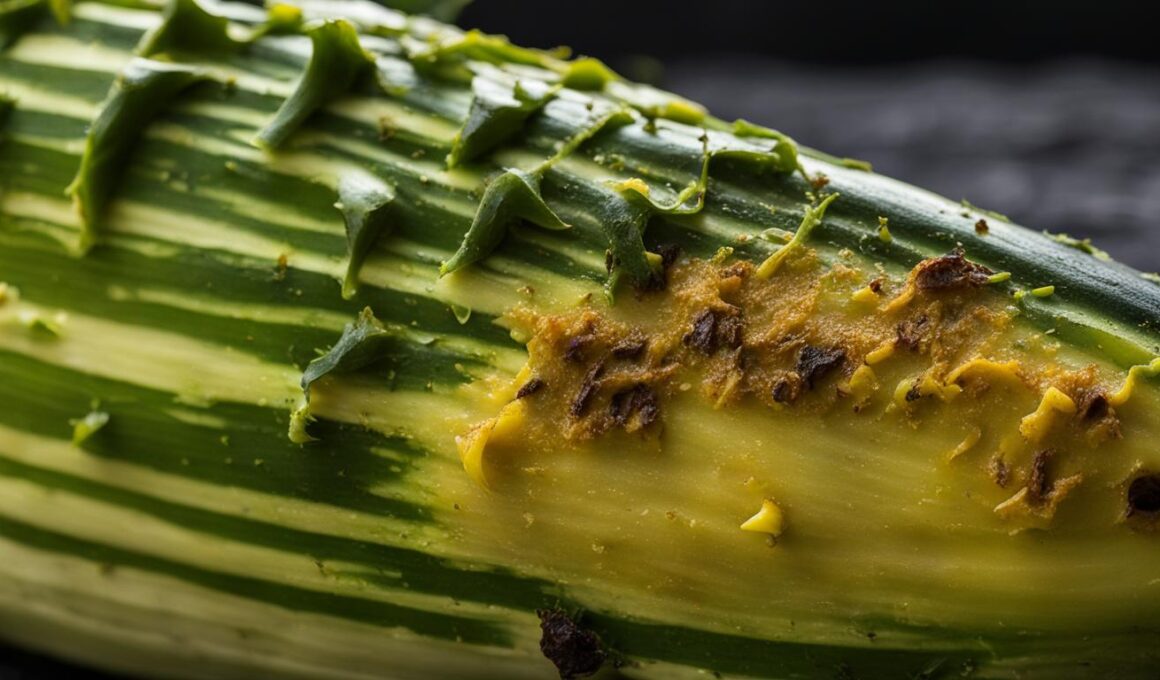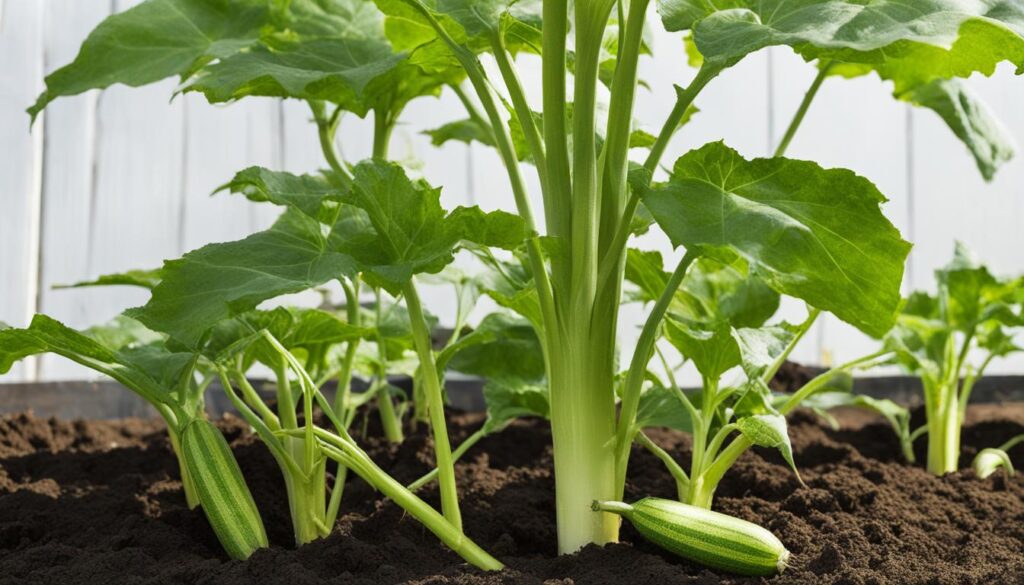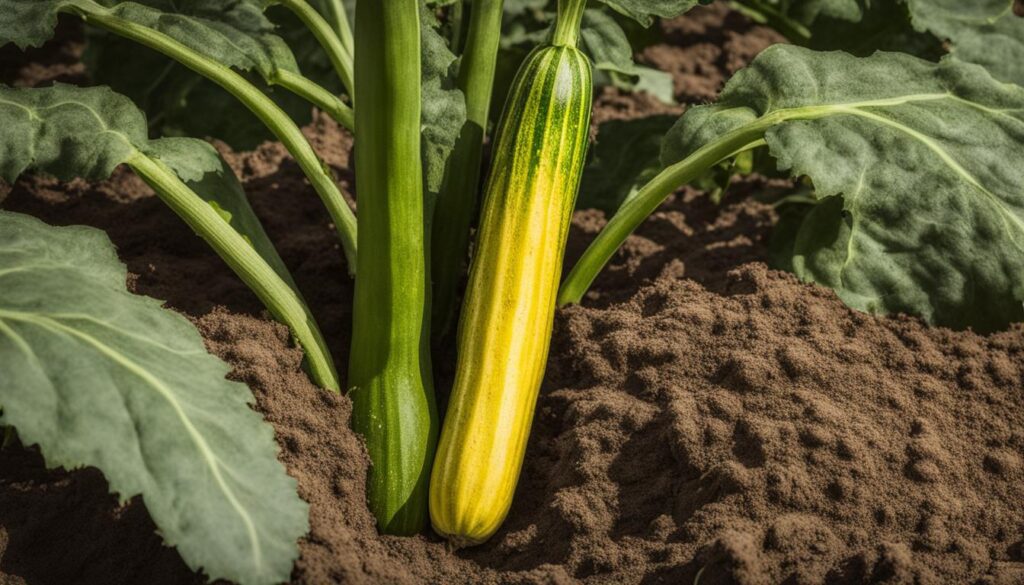Are your zucchini plants suffering from yellowing leaves, browning, and rotting fruit? It’s time to unravel the mystery behind this common problem and restore your plants to a healthy state. Zucchinis are known for their abundant harvests, so it’s crucial to address this issue to ensure a plentiful harvest season.
Post Summary
- Zucchini plants turning yellow and rotting can be caused by pests, diseases, or nutritional imbalances.
- Common pests include cucumber beetles, squash bugs, and aphids, which can transmit diseases.
- Preventative measures like handpicking pests, using organic insecticides, and practicing good sanitation can help control infestations.
- Regular monitoring, proper watering techniques, and optimal environmental conditions are essential to prevent diseases and stress.
- Addressing nutritional imbalances through proper fertilization and soil management is crucial for healthy zucchini plants.
Identifying the Culprit: Pests and Diseases
When it comes to solving the mystery of yellowing and rotting zucchinis, pests and diseases are often the culprits. Understanding the potential pests and diseases that can affect zucchini plants is crucial for maintaining a healthy and fruitful harvest.
Zucchini Pests: Cucumber beetles, squash bugs, and aphids are common pests that can wreak havoc on zucchini plants. These harmful insects feed on the leaves and fruits of the plants, causing damage and weakening their overall health. Fruit flies and earwigs may also be potential culprits, although further investigation is necessary to confirm their involvement.
Zucchini Plant Diseases: Pests can transmit diseases to zucchini plants, further compromising their vitality. Bacterial wilt and powdery mildew are two common diseases that can be transmitted by pests. These diseases can lead to the yellowing and rotting of zucchini fruits. It is essential to be vigilant and inspect the plants regularly for any signs of pest infestation or disease development.
Table: Common Zucchini Pests and Diseases
| Pests | Diseases |
|---|---|
| Cucumber beetles | Bacterial wilt |
| Squash bugs | Powdery mildew |
| Aphids | |
| Fruit flies | |
| Earwigs |
By identifying the specific pests and diseases that may be affecting your zucchini plants, you can take appropriate measures to control and prevent further damage. In the next section, we will explore prevention and control measures that can help you protect your zucchinis and ensure a bountiful harvest.
Prevention and Control Measures
Proper zucchini plant care is essential for preventing and controlling pests and diseases. By following these effective strategies, you can ensure the health and productivity of your zucchini plants.
Pest Control
To keep pests at bay, start by regularly inspecting your plants for any signs of infestation. Handpicking and removing any visible pests can help reduce their population. Introduce beneficial insects like ladybugs and lacewings, which can prey on harmful pests such as aphids and cucumber beetles. Alternatively, you can apply organic insecticides that are safe for both your plants and the environment.
Creating a physical barrier around your zucchini plants using row covers can also prevent pests from laying eggs on the foliage. Remember to remove the covers once the plants start flowering to allow for pollination.
Disease Prevention
Proper sanitation practices are crucial for preventing the spread of diseases. Remove any fallen foliage or plant debris around the zucchini plants, as they can serve as breeding grounds for pests and diseases.
Monitor your plants regularly for any signs of disease, such as wilting, discoloration, or powdery residue on the leaves. If you spot any infected plants, promptly remove and dispose of them to prevent further spread.
Furthermore, provide adequate air circulation by spacing out your zucchini plants properly. This helps reduce humidity levels and prevents the development of fungal diseases like powdery mildew. Water your plants at the base, avoiding overhead watering, as wet foliage can encourage the growth of fungal pathogens.
Incorporating crop rotation into your garden plan can also help lessen the risk of diseases. Avoid planting zucchini or other related crops in the same location consecutively, as this can result in a buildup of pests and diseases in the soil.
Summary
To maintain healthy zucchini plants, prioritize pest control measures such as handpicking, introducing beneficial insects, and using organic insecticides. Implement disease prevention techniques by practicing good sanitation, monitoring for symptoms, and providing proper air circulation and watering. Remember to regularly inspect your plants to catch any issues early on and take necessary action. With these preventive measures in place, you can enjoy a plentiful harvest of vibrant and delicious zucchinis.
Nutritional Imbalances and Environmental Factors
Proper nutrition is essential for the healthy growth of zucchini plants and the development of high-quality fruits. Nutritional imbalances can lead to yellowing and rotting of zucchinis. Common deficiencies that may cause these issues include nitrogen, potassium, and magnesium. These nutrients play vital roles in various plant physiological processes, such as photosynthesis, enzyme activation, and overall plant health.
Monitoring soil pH levels is crucial in ensuring optimal nutrient availability for zucchini plants. Soil pH affects the solubility and accessibility of essential nutrients. Generally, a slightly acidic to neutral pH range of 6.0 to 7.0 is ideal for zucchini plants. If the soil pH deviates from this range, it can result in nutrient deficiencies or toxicities, leading to poor fruit development and rotting.
Environmental factors can also contribute to the yellowing and rotting of zucchinis. Excessive heat and humidity can stress the plants, affecting their overall health and fruit quality. Inconsistent watering practices, such as overwatering or underwatering, can also lead to physiological stress. It is crucial to provide adequate irrigation and ensure proper drainage to prevent waterlogged or drought-stressed plants.
Common Nutritional Imbalances and Symptoms in Zucchini Plants
| Nutrient | Symptoms |
|---|---|
| Nitrogen | Yellowing leaves, stunted growth |
| Potassium | Leaf browning, weak stems |
| Magnesium | Interveinal yellowing, leaf curling |
Remember to regularly monitor your zucchini plants for any signs of nutritional imbalances, such as yellowing leaves or poor fruit development. Conduct soil tests to determine the pH levels and nutrient status of your soil. Adjust pH and apply organic fertilizers or foliar sprays to correct any deficiencies. Provide adequate water and maintain a suitable growing environment to minimize environmental stress.
In the next section, we will explore prevention and control measures to maintain the health and productivity of your zucchini plants.
Conclusion
By implementing effective solutions, you can address the issue of zucchini turning yellow and rotting, ensuring the health and productivity of your plants.
To combat pests and diseases, consider techniques such as handpicking, using organic insecticides, and introducing natural predators to control harmful insects. Maintaining good sanitation practices, such as removing fallen foliage and debris, can also help reduce breeding grounds for pests. Additionally, practice disease prevention by adopting proper watering techniques, ensuring adequate air circulation, and regularly monitoring for symptoms. Crop rotation and selecting disease-resistant varieties can further minimize the risk of infection.
Nutritional imbalances can be addressed through proper fertilization and maintaining suitable soil pH levels. Be mindful of environmental stress factors such as excessive heat, humidity, or inconsistent watering, which can negatively impact zucchini plants. Strive for optimal growing conditions by providing the right amount of water, sufficient sunlight, and maintaining a consistent temperature.
With these solutions, you can enjoy a plentiful harvest of healthy zucchinis. Whether you prefer grilled zucchinis or delicious zucchini bread, your garden will yield robust and flavorful produce that you can savor with confidence.
FAQ
What could be causing my zucchinis to turn yellow and rot?
Possible causes include pests such as cucumber beetles or squash bugs, diseases like bacterial wilt or powdery mildew, nutritional imbalances, or environmental factors like excessive heat or inconsistent watering.
How can I prevent and control pests on my zucchini plants?
Techniques like handpicking, applying organic insecticides, or introducing natural predators can be effective. Practicing good sanitation, such as removing fallen foliage and cleaning up debris, can also help reduce potential breeding grounds for pests.
What should I do to prevent diseases on my zucchini plants?
Proper watering techniques, adequate air circulation, and regular monitoring for symptoms are crucial. Crop rotation and planting disease-resistant varieties can also help minimize the risk of infection.
Are there any nutritional deficiencies that could be causing my zucchinis to turn yellow and rot?
Deficiencies in essential nutrients like nitrogen, potassium, or magnesium can lead to yellowing and rotting of zucchinis. Soil pH levels can also affect nutrient availability.
How can I address environmental factors that may be affecting my zucchini plants?
It is important to ensure proper fertilization and watering practices, as well as maintaining optimal environmental conditions. This includes providing adequate air circulation, avoiding excessive heat or humidity, and ensuring consistent watering.
What Causes Zucchini to Turn Yellow and Rot, and How Can It Be Prevented?
Zucchini turning yellow and rotting can be attributed to several factors. Excessive moisture, inadequate sunlight, or fungal diseases like blossom end rot can cause this issue. To prevent it, ensure proper drainage, provide sufficient sunlight, and maintain consistent soil moisture levels. Applying calcium-rich supplements can also aid against blossom end rot. Understanding the brassica vs hibiscus flower differences is unrelated to this topic but can be fascinating to explore separately.











